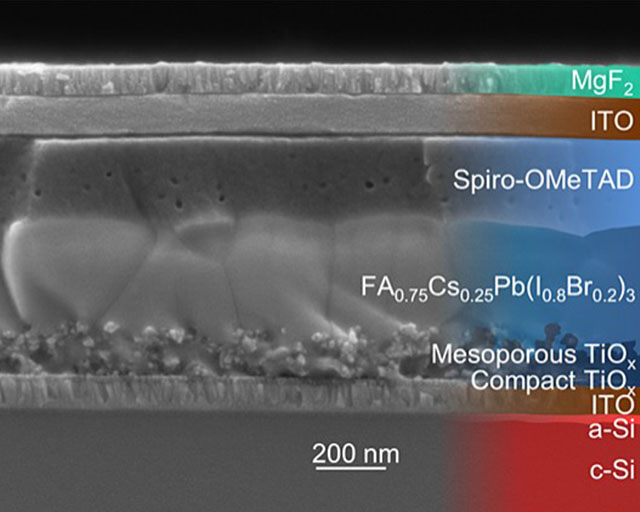Fraunhofer lighthouse project “MaNiTU”
Fraunhofer lighthouse project “MaNiTU” develops materials for sustainable tandem solar cells
Solar cells with the highest level of efficiency provide electricity cost-effectively and thereby consume less space and fewer resources. They also enable the creation of new products, such as electric cars, which can be charged via solar cells. Due to the physical limitations, the efficiency of silicon solar cells can no longer be increased arbitrarily. With tandem solar cells comprised of several light-absorbing layers, however, efficiency levels of more than 35 % are possible, as a result of which they have become the focus of current solar-cell research. In the Fraunhofer lighthouse project “MaNiTU”, six Fraunhofer institutes are developing sustainable, highly efficient and cost-effective tandem solar cells on the basis of new absorber materials.


“For Germany, the development of innovative and disruptive technologies such as tandem solar cells offers the opportunity to regain a leading international position in the production of solar cells - in addition to research, plant construction and material supply. MaNiTU therefore also opens up an alternative perspective for a successful European PV manufacturing industry,” explains Dr. Andreas Bett, Director of the Fraunhofer Institute for Solar Energy Systems ISE, who is in charge of the project.
The project “MaNiTU - Materialien für nachhaltige Tandemsolarzellen mit höchster Umwandlungseffizienz” (Materials for sustainable tandem solar cells with highest conversion efficiency) focuses on perovskite solar-cell technology, which has increased efficiency levels from 3.8 % to 24.2 % within the last 10 years, enables simple production and promises very low production costs. Perovskite materials are all materials whose crystal structure corresponds to that of the mineral calcium titanate. Such materials can absorb light particularly well and enable high electron mobility - ideal for use in photovoltaics. Furthermore, due to its physical properties, this class of materials is also suitable for use in tandem structures based on silicon solar cells.
This material is, however, not unproblematic due to the utilization of lead. As annual photovoltaic installations worldwide will increase to more than 1 TWp within the next 5-10 years, critical materials in the manufacture of solar modules must be rigorously avoided. On the basis of known perovskite absorber materials, “MaNiTU” is therefore developing new lead-free absorber layers as well as optimally compatible contact and passivation layers using ultramodern material science methods, whereby critical and toxic substances are excluded from the outset. The innovative approach of addressing absorber and contact layers simultaneously facilitates the targeted implementation of interface effects for the desired functionalities. Perovskite technology will then be combined with established silicon technology. The perovskite solar cells will be deposited directly onto silicon solar cells. As the individual solar cells each use different parts of the solar spectrum particularly efficiently, the overall efficiency level increases and more electricity can be produced with the same solar-cell area. At the end of the project, stability and high efficiency level will be demonstrated at the module level.
The Fraunhofer lighthousep project is scheduled to have a duration of four years. The aim of this research program is the exploitation of the Fraunhofer synergy potential through the amalgamation of the competencies of several Fraunhofer institutes in order to provide solutions for the challenges faced by German industry.
The ambitious “MaNiTU” project objectives demand that the complementary areas of expertise of various Fraunhofer institutes be amalgamated - from theoretical and experimental materials management through to technological, economic and ecological expertise in solar cells.
In the Fraunhofer lighthouse project “MaNiTU”, six Fraunhofer institutes are combining their competencies:
- Fraunhofer Institute for Solar Energy Systems ISE:
- Development of highly efficient tandem solar cells
- Sustainability assessment of overall system
- Fraunhofer Institute for Silicate Research ISC:
- Wet-chemical material synthesis
- Application of particle-based electrode/absorber layers
- Fraunhofer Institute for Mechanics of Materials IWM:
- Material design
- Atomistic material modelling
- Computer simulation
- Fraunhofer Institute for Surface Engineering and Thin Films IST:
- Research and application of coating processes
- Sustainability assessment
- Optimization of energy and material flows
- Fraunhofer Institute for Microstructure for Materials and Systems IMWS:
- Microstructural analytics
- Optoelectrical characterization for perovskite solar cells
- Microstructural analytics
- Fraunhofer Research Institution for Materials Recycling and Resource Strategies IWKS:
- Material cycles
- Development of lead-free substitution materials
Additional information can be found at www.manitu.fraunhofer.de
Last modified: